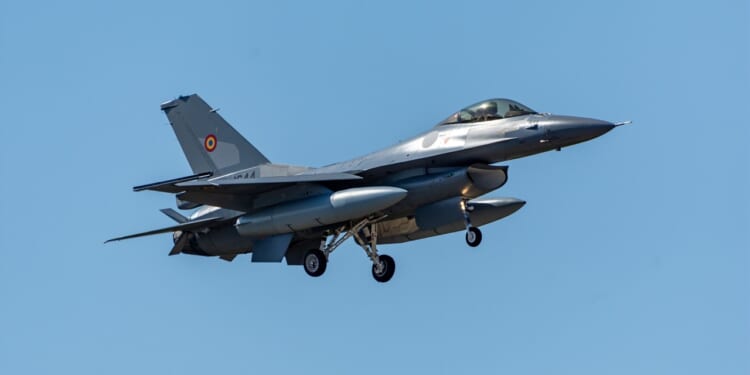Romania is already home to NATO’s main base for training future F-16 pilots—including future Ukrainian operators of the American-made fighter jets.
The close ties that currently exist within the NATO alliance were on display earlier this month, as the Netherlands officially transferred 18 of its American-made F-16 Fighting Falcon multirole jet fighters—for the “symbolic price” of a single euro.
All 18 of the fighters are already in Romania at the European F-16 Training Center (EFTC), the only training facility in Europe for prospective Fighting Falcon pilots. Located at the Romanian Air Force 76th Air Base near Fetești, the center was established two years ago with assistance from Lockheed Martin, which continues to produce the F-16 for foreign military sales.
Fourteen of the aircraft arrived when the EFTC became operational in November 2023, with the other four arriving at a later date.
Romanian Pilots Are Training on the F-16 Fighting Falcon
EFTC graduated its first class of mission-ready F-16 pilots in July 2024, and all seven were aviators with the Romanian Air Force who completed an advanced flight operations and tactics course.
The training became necessary as Romania received 67 of the single-engine, multirole fighters from a range of NATO nations as part of a planned arms buildup. Bucharest is also on track to receive additional refurbished Fighting Falcons from Norway in the near future. The aircraft will enhance Romania’s capabilities and bolster NATO’s eastern flank, replacing its aging Soviet-era MiG-21 (NATO reporting name “Fishbed”) that had been in service since before the end of the Cold War.
However, the F-16s are a stopgap measure until Romania begins to receive the F-35 Lightning II, which is expected to start at the end of the decade. In 2022, Bucharest became the 20th country to conclude a deal for the fifth-generation stealth fighter, and it is set to receive 32 of the advanced aircraft.
Once those aircraft arrive, the EFTC will likely expand to include F-35 training, shifting it away from being exclusively carried out in the United States.
Romania Plans to Expand Its F-16 Training Facilities
According to The Netherlands Times, the 18 aircraft, along with spare parts and training simulators, were valued at €65 million. As part of the deal for the Fighting Falcons, Romania will make half of the training capacity at EFTC available to Ukrainian pilots for the next few years.
The Dutch government has provided 24 of its former F-16 Fighter Jets to Kyiv. Other NATO members, including Belgium, Denmark, and Norway, have also pledged to supply additional Fighting Falcons.
Even as NATO allies have promised to supply around 90 American-made F-16s to Ukraine, training has been slow-going, highlighting the void that the EFTC could now fill.
NATO Plans to Train Young Ukrainian Pilots on Western Fighters
The future Ukrainian pilots set to undergo F-16 training could be younger and less experienced, but that is very much by design.
Initially, experienced Ukrainian pilots were prioritized for training on the F-16 Fighting Falcon. However, the demanding pace, language barriers, and differences in training styles led to setbacks, including a veteran pilot crashing in his F-16 in August 2024, just weeks after the first F-16s arrived in the country.
Younger pilots might be better-suited to the new aircraft. For one thing, they would have less to unlearn, not having been trained on very different Soviet- and Russian-made equipment. They are also expected to have an easier time with the language, as many Ukrainians in the 18- to 29-year-old age group have higher English skills than those over the age of 30. Exposure to English through the Internet, video games, and other media has significantly improved the language skills of the younger generation.
Last year, it was announced that future training would take place in Romania and be supported by alliance members, including Greece, with the goal shifted to streamlining and localizing the program. Ukrainian officials also began to prioritize training for younger pilots, as it wouldn’t necessitate the need to “relearn” on an entirely different platform.
One irony is that many of those who would-be F-16 pilots will head to neighboring Romania instead of receiving the full American experience—including language training at Lackland Air Force Base (AFB) in San Antonio, followed by flight training at Morris Air National Guard Base in Tucson, Arizona.
About the Author: Peter Suciu
Peter Suciu has contributed over 3,200 published pieces to more than four dozen magazines and websites over a 30-year career in journalism. He regularly writes about military hardware, firearms history, cybersecurity, politics, and international affairs. Peter is also a contributing writer for Forbes and Clearance Jobs. He is based in Michigan. You can follow him on Twitter: @PeterSuciu. You can email the author: [email protected].
Image: Shutterstock / Pucs Fongabe.
















